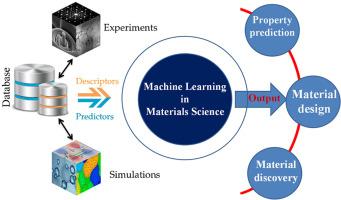Machine learning-driven materials discovery: Unlocking next-generation functional materials – A review
IF 3.9
Q3 PHYSICS, CONDENSED MATTER
引用次数: 0
Abstract
The rapid advancement of machine learning and artificial intelligence (AI)-driven techniques is revolutionizing materials discovery, property prediction, and material design by minimizing human intervention and accelerating scientific progress. This review provides a comprehensive overview of smart, machine learning (ML)-driven approaches, emphasizing their role in predicting material properties, discovering novel compounds, and optimizing material structures. Key methodologies in this field include deep learning, graph neural networks, Bayesian optimization, and automated generative models (GANs, VAEs). These approaches enable the autonomous design of materials with tailored functionalities. By leveraging AutoML frameworks (AutoGluon, TPOT, and H2O.ai), researchers can automate the model selection, hyperparameter tuning, and feature engineering, significantly improving the efficiency of materials informatics. Furthermore, the integration of AI-driven robotic laboratories and high-throughput computing has established a fully automated pipeline for rapid synthesis and experimental validation, drastically reducing the time and cost of material discovery. This review highlights real-world applications of automated ML-driven approaches in predicting mechanical, thermal, electrical, and optical properties of materials, demonstrating successful cases in superconductors, catalysts, photovoltaics, and energy storage systems. We also address key challenges, such as data quality, interpretability, and the integration of AutoML with quantum computing, which are essential for future advancements. Ultimately, combining AI with automated experimentation and computational modeling is transforming the way materials are discovered and optimized. This synergy paves the way for new innovations in energy, electronics, and nanotechnology.

机器学习驱动的材料发现:解锁下一代功能材料-综述
机器学习和人工智能(AI)驱动技术的快速发展,通过最大限度地减少人为干预和加速科学进步,正在彻底改变材料发现、性能预测和材料设计。这篇综述全面概述了智能机器学习(ML)驱动的方法,强调了它们在预测材料性能、发现新化合物和优化材料结构方面的作用。该领域的关键方法包括深度学习,图神经网络,贝叶斯优化和自动生成模型(gan, VAEs)。这些方法能够自主设计具有定制功能的材料。通过利用AutoML框架(AutoGluon、TPOT和H2O)。Ai),研究人员可以自动化模型选择,超参数调整和特征工程,显着提高材料信息学的效率。此外,人工智能驱动的机器人实验室和高通量计算的集成已经建立了一个全自动的管道,用于快速合成和实验验证,大大减少了材料发现的时间和成本。这篇综述强调了自动化机器学习驱动方法在预测材料的机械、热、电和光学性质方面的实际应用,展示了超导体、催化剂、光伏和储能系统中的成功案例。我们还解决了关键挑战,例如数据质量,可解释性以及AutoML与量子计算的集成,这些对未来的进步至关重要。最终,将人工智能与自动化实验和计算建模相结合,正在改变发现和优化材料的方式。这种协同作用为能源、电子和纳米技术的新创新铺平了道路。
本文章由计算机程序翻译,如有差异,请以英文原文为准。
求助全文
约1分钟内获得全文
求助全文
来源期刊

Computational Condensed Matter
PHYSICS, CONDENSED MATTER-
CiteScore
3.70
自引率
9.50%
发文量
134
审稿时长
39 days
 求助内容:
求助内容: 应助结果提醒方式:
应助结果提醒方式:


